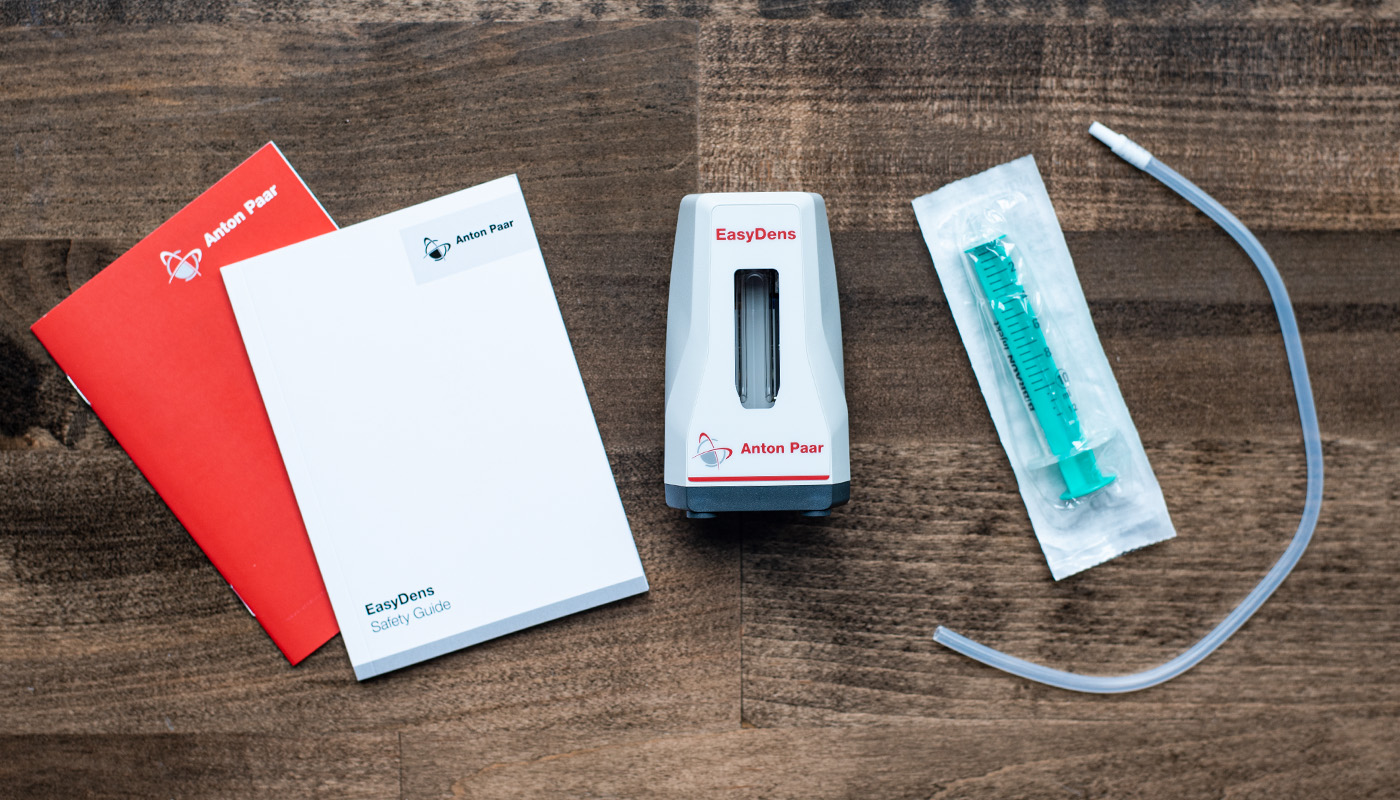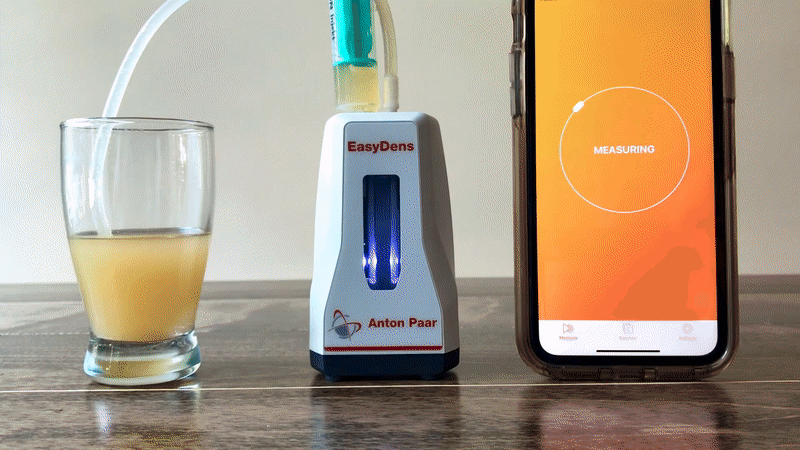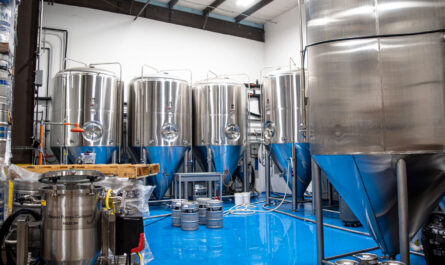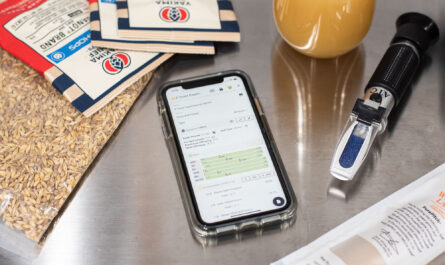Anton Paar generously provided the New EasyDens in exchange for an honest product review.
Calculating specific gravity (SG) is an essential part of every single brew day. Homebrewers use SG or °Plato to calculate alcohol percentage, determine brewhouse efficiency, and monitor fermentation progress. It’s certainly not the most glamorous part of the process but it’s absolutely essential for both beginners and advanced brewers.
If you’ve ever used a refractometer, hydrometer, or floating hydrometer, you understand the pros and cons of each tool. Refractometers are great for quickly measuring specific gravity with a single drop of wort, but they’re not always accurate and fall short when alcohol is added to the equation.
Hydrometers are probably the better all-around tool but require temperature correction and much more liquid volume for an accurate reading. But what other options do homebrewers have that ultimately meet in the middle? Enter the second-generation EasyDens by Anton Paar—a faster and more accurate model than its predecessor.
Product Overview

Anton Paar produces high-end analytical testing equipment for commercial breweries. Borrowing similar technology, the New EasyDens gives homebrewers and small commercial breweries a powerful tool for measuring SG at a fraction of the cost. The New EasyDens by Anton Paar is a precise digital density meter/hydrometer that measures SG/°Plato in both wort and finished beer. While it can also be used to measure alcohol content (ABV) in spirits, °Brix (sugar), and density, my experience is only related to beer and the brewing process.
The New EasyDens is compact, offers a completely digital interface, has built-in temperature compensation, and only requires 2ML of liquid to take an accurate measurement. It’s incredibly easy to use and ideal for rapid measurements during any stage of the brewing process. The EasyDens comes with a free mobile app (Brew Meister) that ultimately controls the device and displays various readings.
Advantages of the New EasyDens:
- New design (smaller and lightweight)
- Higher stability due to optimized and balanced layout
- Faster connection due to new generation Bluetooth chip
- Faster measurement
- Dust and spray water protection (IP65 protection)
Using the EasyDens
I’ll be completely honest with you, after hearing a lot of buzz about EasyDens and seeing it all over social media, I was a little skeptical that it would be a cumbersome or overly complicated tool that wasn’t worth the money or effort to clean. Boy was I wrong. Upon unboxing my EasyDens, I downloaded the Brew Meister app and my phone automatically discovered and paired my device with the click of a button. In about 30 seconds I was up and running and ready to take my first gravity sample.

Using EasyDens is as simple as collecting 2-3ML of wort/beer using the supplied syringe and injecting it into one of the top ports of the EasyDens. The supplied silicone tubing directs the waste beer/wort back out of the second port and into a cup or sink. The only thing you need to make note of is ensuring the U-shaped channel is full of fluid and free of gas bubbles before taking a reading. Press ‘START’ within the mobile app and you have a gravity reading in about 5 seconds.
After using EasyDens for a week, I was blown away by how simple and convenient it makes taking gravity readings. I have a tremendous amount of trust in the precision of the device and no longer have to worry about reading the tiny graduated lines on my hydrometer or compensating for temperature correction. Just to note, the safe temperature range is 32°F-176°F. For most accurate measurements, beer/wort should be between 41°F-86°F (5°C to 30°C). This is a plus when it comes to taking hot side measurements!

While the instructions recommend degassing carbonated beer before testing, I still found it to be pretty accurate with fully carbonated samples. This is incredibly useful for quickly analyzing the final gravity of commercial beers. As someone who loves to analyze and understand the character of my favorite commercial brews, this makes life a lot easier and doesn’t waste precious beer.
Cleaning
Cleaning EasyDens is a matter of flushing the unit with distilled water. Pure water won’t leave behind any unwanted minerals that could shorten the lifespan of the tool. All I do is rinse my syringe and suck up some distilled water and then push it through just like a beer sample. Quick and easy.
The Brew Meister App
While most homebrewers likely have brewing software to record various gravity readings throughout the brewing process, the app has a native batch tool that allows you to save and assign your readings to a given batch. This is useful for plotting gravity and temperature points and determining ABV/apparent attenuation upon completion. You can easily save a real-time reading to your current batch or you can input them manually if you forget to save anything.
My particular test batch brewed with S-04 fermented in about 48 hours so I only recorded 3 readings. The app can be instantly toggled between specific gravity and °Plato and of course Celsius and Fahrenheit. Overall, it’s really easy to use and the functionality has really impressed me. The Brew Meister app is available on the Apple App Store and Google Play.
Full disclosure, I own a floating hydrometer that automatically captures temp and gravity readings every 15 minutes and maps them to my brew software during fermentation. While this serves as a general guide to monitor progress, the EasyDens is a much more reliable tool in determining accurate SG points at any step of the process.
The problem with floating hydrometers is their lack of accuracy when it comes to active fermentation. Krausen and air bubbles tend to distort results and give false readings. While these tools are great for ballpark figures, EasyDens is what I rely on for official gravity readings. It’s the same level of trust you get from a standard hydrometer but with greater accuracy, much less beer loss, and faster readings.
Drawbacks
I really don’t have many negative things to say about EasyDens. It’s an awesome tool that will absolutely hold an important place in my brew days to come. I honestly don’t see myself going back to a refractometer or hydrometer when I can ensure more consistent and accurate results from a single device throughout the whole brewing process. Plus, it’s just that easy to use.

The only additional feature on my wish list would be ABV calculation in beers without the need for OG/FG inputs. While EasyDens can determine the ABV for binary mixtures such as gin or vodka, it can only calculate an estimation for ABV in beer using OG/FG inputs. The only other real downside is the cost. At $349, it’s an expensive tool that’s certainly a premium product geared towards serious homebrewers or smaller commercial breweries. That being said, I still think it’s worth the money given the technology, accuracy, and overall time savings.
Final Thoughts
I would absolutely recommend EasyDens for anyone looking for more accurate gravity readings and analysis throughout the brewing process. If you’re a complete beer nerd like me and enjoy examining more than just your own beers, the EasyDens makes that easier as well. It’s certainly a premium tool and not in everyone’s budget, but I still think you’re getting a high-value and quality product for the money. The plus is you really don’t need any other tool for measuring SG. The EasyDens replaces everything in your repertoire with a single device.









Not sure if this is something new but Anton Parr currently wants a $25 annual subscription fee to add new batches. Yes, it’s possible to take measurements and record them in a separate log/spreadsheet without paying anything extra. That said, having the ability to view results graphically in the app before exporting those measurements partially offsets the annual fee. Also, there may be work-arounds to avoid Anton Parr’s fees.
I wonder what the expected lifespan of this product is, assuming it’s maintained in line with recommendations. Will the sensor ever wear out?